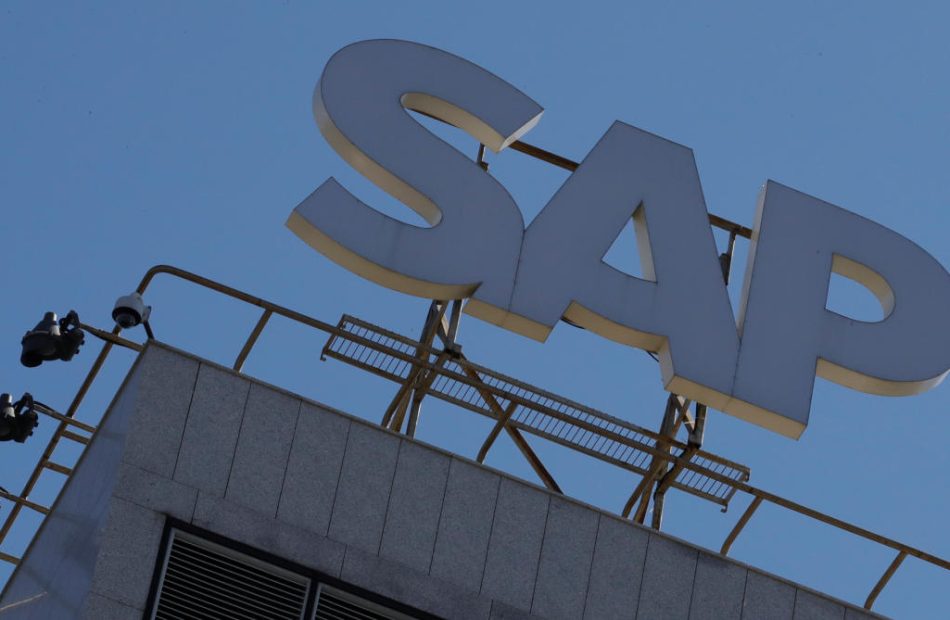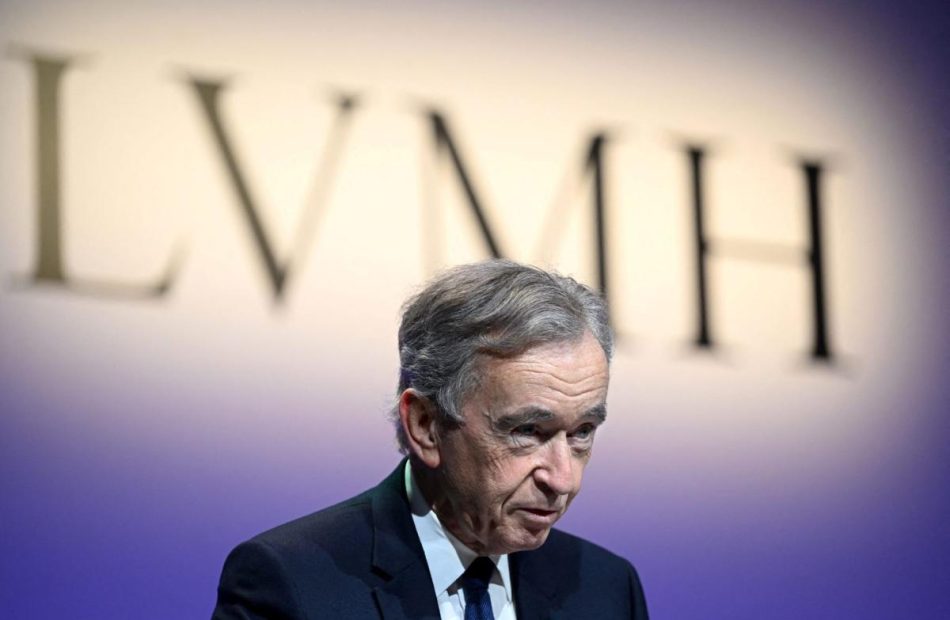US investigates tech firms SAP, Carahsoft for potential price-fixing, Bloomberg News reports
(Reuters) -The U.S. is investigating German software firm SAP, U.S. IT services provider Carahsoft Technology, and others in a civil probe for potentially conspiring to overcharge government agencies over the course of a decade, Bloomberg News reported late Tuesday.
The U.S. Department of Justice (DOJ) lawyers have been investigating since at least 2022 whether SAP illegally conspired with Carahsoft to fix prices on sales to the U.S. military and other parts of the government, Bloomberg said, citing federal court documents filed in Baltimore.
In an emailed statement, SAP said it was under a civil investigation by the DOJ and did not disclose further details.
“All we can say is that there has been a civil investigation by the DOJ, and SAP has been cooperating with the investigation since the beginning,” the German firm said. The company was not aware of any criminal investigation, it added.
SAP shares fell 3.3% to 200.1 euros on Wednesday.
Bloomberg reported that the civil probe is focused on the companies possibly rigging the market for the more than $2 billion worth of SAP technology that the U.S. government has purchased since 2014.
The DOJ lawyers are also examining the role of other software resellers and a unit of Accenture, the report added, citing court documents.
An Accenture spokesperson told Bloomberg that the unit, Accenture Federal Services LLC, “is responding to an administrative subpoena and is cooperating with the DOJ.” The firm did not respond to a Reuters request for comment.
On Tuesday, Bloomberg reported that U.S. federal agents had searched the Washington-area offices of Carahsoft. The company told Bloomberg that the investigation was into a company with which it had done business in the past.
Carahsoft did not respond to a request for comment outside regular business hours. Bloomberg said it was not clear if the search was related to SAP.
(Reporting by Angela Christy and Shubham Kalia in Bengaluru; Editing by Abinaya Vijayaraghavan)
Insider Decision: Ashley Kavanaugh Offloads $399K Worth Of Range Resources Stock
A substantial insider sell was reported on September 23, by Ashley Kavanaugh, VP at Range Resources RRC, based on the recent SEC filing.
What Happened: Kavanaugh’s recent Form 4 filing with the U.S. Securities and Exchange Commission on Monday unveiled the sale of 12,700 shares of Range Resources. The total transaction value is $399,389.
Tracking the Tuesday’s morning session, Range Resources shares are trading at $31.59, showing a up of 0.22%.
Unveiling the Story Behind Range Resources
Fort Worth-based Range Resources is an independent exploration and production company with that focuses entirely on its operations in the Marcellus Shale in Pennsylvania. At year-end 2023, Range Resources’ proven reserves totaled 18.1 trillion cubic feet equivalent, with net production of 2.14 billion cubic feet equivalent per day. Natural gas accounted for 69% of production.
Breaking Down Range Resources’s Financial Performance
Revenue Challenges: Range Resources’s revenue growth over 3 months faced difficulties. As of 30 June, 2024, the company experienced a decline of approximately -0.0%. This indicates a decrease in top-line earnings. In comparison to its industry peers, the company trails behind with a growth rate lower than the average among peers in the Energy sector.
Evaluating Earnings Performance:
-
Gross Margin: The company faces challenges with a low gross margin of 17.01%, suggesting potential difficulties in cost control and profitability compared to its peers.
-
Earnings per Share (EPS): With an EPS below industry norms, Range Resources exhibits below-average bottom-line performance with a current EPS of 0.12.
Debt Management: Range Resources’s debt-to-equity ratio is below the industry average at 0.48, reflecting a lower dependency on debt financing and a more conservative financial approach.
Market Valuation:
-
Price to Earnings (P/E) Ratio: The P/E ratio of 15.84 is lower than the industry average, implying a discounted valuation for Range Resources’s stock.
-
Price to Sales (P/S) Ratio: A higher-than-average P/S ratio of 3.25 suggests overvaluation in the eyes of investors, considering sales performance.
-
EV/EBITDA Analysis (Enterprise Value to its Earnings Before Interest, Taxes, Depreciation & Amortization): A high EV/EBITDA ratio of 6.62 reflects market recognition of Range Resources’s value, positioning it as more highly valued compared to industry peers.
Market Capitalization Analysis: Reflecting a smaller scale, the company’s market capitalization is positioned below industry averages. This could be attributed to factors such as growth expectations or operational capacity.
Now trade stocks online commission free with Charles Schwab, a trusted and complete investment firm.
Why Pay Attention to Insider Transactions
While insider transactions should not be the sole basis for making investment decisions, they can play a significant role in an investor’s decision-making process.
When discussing legal matters, the term “insider” refers to any officer, director, or beneficial owner holding more than ten percent of a company’s equity securities, as stipulated in Section 12 of the Securities Exchange Act of 1934. This includes executives in the c-suite and significant hedge funds. Such insiders are required to report their transactions through a Form 4 filing, which must be completed within two business days of the transaction.
A new purchase by a company insider is a indication that they anticipate the stock will rise.
On the other hand, insider sells may not necessarily indicate a bearish view and can be motivated by various factors.
A Closer Look at Important Transaction Codes
Delving into transactions, investors typically prioritize those unfolding in the open market, as precisely outlined in Table I of the Form 4 filing. A P in Box 3 indicates a purchase, while S signifies a sale. Transaction code C signals the conversion of an option, and transaction code A denotes a grant, award, or other acquisition of securities from the company.
Check Out The Full List Of Range Resources’s Insider Trades.
Insider Buying Alert: Profit from C-Suite Moves
Benzinga Edge reveals every insider trade in real-time. Don’t miss the next big stock move driven by insider confidence. Unlock this ultimate sentiment indicator now. Click here for access.
This article was generated by Benzinga’s automated content engine and reviewed by an editor.
Market News and Data brought to you by Benzinga APIs
© 2024 Benzinga.com. Benzinga does not provide investment advice. All rights reserved.
Billionaire David Tepper Sold 84% of Appaloosa's Stake in Nvidia and Is Piling Into This Historically Cheap Cyclical Stock
Although all eyes have seemingly been on the Federal Reserve and monthly inflation reports of late, what can arguably be described as the most important data release of the third quarter occurred roughly six weeks ago.
On Aug. 14, institutional investors with at least $100 million in assets under management were required to file Form 13F with the Securities and Exchange Commission. A 13F provides investors with an over-the-shoulder look of which stocks Wall Street’s most-successful money managers purchased and sold in the most recent quarter (in this case, the June-ended quarter).
While 13Fs have their noted flaws — they’re 45 days old when filed, thus providing stale information for active hedge funds — they can still offer invaluable guidance as to which stocks, industries, sectors, and trends have the undivided attention of Wall Street’s greatest investment minds.
Aside from seeing what Wall Street’s most-prominent investors has been up to, such as Warren Buffett at Berkshire Hathaway, investors tend to play very close attention to what billionaire David Tepper and his team have been up to at Appaloosa. That’s because Tepper’s fund has posted a gross annualized return of more than 28% in the 30-year stretch from its inception in 1993 through 2023.
Interestingly, Tepper and his team were big-time net-sellers of equities during the second quarter, with nine positions being added to, two positions completely closed, and 26 reduced. Perhaps none of these reductions stand out more than artificial intelligence (AI) leader Nvidia (NASDAQ: NVDA).
David Tepper slashed his fund’s stake in AI colossus Nvidia — and probably for good reason
Tepper’s Appaloosa closed out the March-ended quarter with 4.42 million shares of Nvidia. Between the start of April and the end of June, amid Nvidia’s historic 10-for-1 stock split and its march to an all-time intra-day high of $140.76 per share, Tepper oversaw the disposition of 3.73 million shares, or 84.39% of his fund’s previous stake.
While some of this selling activity likely had to do with locking in profits on a position that’s up substantially since it was initiated in the first quarter of 2023, there are a number of other reasons Tepper and his team likely jettisoned most of their stake in Nvidia.
For starters, there are viable reasons to believe an AI bubble is brewing. No company on the leading edge of a next-big-thing technology or innovation for 30 years has escaped a bubble-bursting event. With most businesses lacking well-defined plans to generate a positive return on their AI investments anytime soon, it looks as if investors have, once again, overestimated the uptake and utility of a new technology. If the AI bubble bursts, no company would take it on the chin more than Nvidia.
Tepper and his team at Appaloosa may also be expecting competition to ramp up in the AI arena. Though Nvidia’s graphics processing units (GPUs) accounted for a roughly 98% share of those shipped in 2022 and 2023 to data centers, external competitors are ramping up production of their AI-GPUs.
Furthermore, all four of Nvidia’s top customers by net sales are working on AI-GPUs for use in their data centers. Even though Nvidia’s hardware should retain is computing superiority, the cost and supply advantage of using internally developed chips means Nvidia is going to lose out on future orders.
Insider selling is yet another reason Appaloosa’s brightest investors might be souring on Nvidia. While there are a number of reasons to sell stock, some of which are benign, the only reason to purchase shares on the open market is because you think they’ll head higher. The last time an Nvidia insider bought shares of their company’s stock on the open market was December 2020!
The final piece of the puzzle is that David Tepper traditionally focuses on undervalued or distressed assets. Right now, the stock market is historically pricey. When equities eventually roll over, which is what happens when valuations become extended, companies with lofty premiums, such as Nvidia, are often hit the hardest.
But what’s even more interesting than billionaire David Tepper dumping most of his fund’s stake in Nvidia is the exceptionally cheap cyclical stock he chose to pile into during the June-ended quarter.
Billionaire David Tepper can’t stop buying this historically cheap consumer cyclical stock
Though Tepper and his team added to nine existing positions in the second quarter, the one that really stands out is the 660,737 shares purchased of China’s No. 2 e-commerce company, JD.com (NASDAQ: JD). This increased Appaloosa’s stake by a little over 18% and lifted the fund’s holding to 4,310,600 shares, which is worth about $116 million, as of this writing.
China stocks have absolutely hit a rough patch over the past couple of years. Stringent provincial lockdowns and mitigation measures during the COVID-19 pandemic resulted in all sorts of supply chain problems for the world’s No. 2 economy.
To add, China’s regulatory climate is strict and unpredictable. Even with faster economic growth, investors tend to be leery about paying higher multiples for China-based stocks given regulatory unknowns.
Nevertheless, JD has a number of long-term catalysts in its sails, and its stock is jaw-droppingly cheap.
The obvious catalyst for JD is that China’s economy usually grows at a faster pace than most developed countries. While the economic ramp-up since COVID-19 restrictions were lifted in December 2022 has been disappointing, the Chinese economy should find its footing relatively soon.
Building on this point, China is still in the relatively early stages of expanding the reach of e-commerce to its burgeoning middle class. Whereas e-commerce is a mature concept in the U.S., it can still offer substantive growth in the world’s No. 2 economy.
On a more company-specific basis, JD appears better equipped to deliver superior long-term margins when compared to China’s leading online retail sales platform, Alibaba. Whereas the latter generates the bulk of its revenue from acting as a third-party marketplace, JD operates more like Amazon. In other words, it controls the inventory and logistics needed to get products to consumers, once ordered. Being able to control more aspects of its network should allow JD to outpace Alibaba on the margin front.
JD is also generating enough cash flow and has deep enough pockets to branch into new ventures. Aside from its Logistics operations, it has a Health division, and has been aggressively investing in AI to improve various facets of its company. This includes leaning on AI to make predictions about its supply chain and inventory.
Lastly, JD is swimming in cash. It closed out June with $28.8 billion in cash, cash equivalents, short-term investments, and restricted cash, compared to $8.6 billion in short- and long-term debts and unsecured senior notes. That’s just over $20 billion in net cash for a company with a $41 billion market cap.
As of the closing bell on Sept. 18, shares of JD were trading at just 6.5 times consensus earnings per share for 2025 — and this doesn’t account for nearly half the company’s value being tied up in cash. It’s an incredible bargain that billionaire David Tepper is smart to pile into.
Should you invest $1,000 in Nvidia right now?
Before you buy stock in Nvidia, consider this:
The Motley Fool Stock Advisor analyst team just identified what they believe are the 10 best stocks for investors to buy now… and Nvidia wasn’t one of them. The 10 stocks that made the cut could produce monster returns in the coming years.
Consider when Nvidia made this list on April 15, 2005… if you invested $1,000 at the time of our recommendation, you’d have $710,860!*
Stock Advisor provides investors with an easy-to-follow blueprint for success, including guidance on building a portfolio, regular updates from analysts, and two new stock picks each month. The Stock Advisor service has more than quadrupled the return of S&P 500 since 2002*.
*Stock Advisor returns as of September 23, 2024
John Mackey, former CEO of Whole Foods Market, an Amazon subsidiary, is a member of The Motley Fool’s board of directors. Sean Williams has positions in Amazon and JD.com. The Motley Fool has positions in and recommends Amazon, Berkshire Hathaway, JD.com, and Nvidia. The Motley Fool recommends Alibaba Group. The Motley Fool has a disclosure policy.
Billionaire David Tepper Sold 84% of Appaloosa’s Stake in Nvidia and Is Piling Into This Historically Cheap Cyclical Stock was originally published by The Motley Fool
A laid-off Foot Locker employee shorted the stock and made over $100,000, authorities say
Financial watchdogs charged a 56-year-old New Yorker with insider trading on Tuesday, alleging the executive knew in advance that Foot Locker’s disappointing earnings would trigger a stock selloff. In total, authorities said the exec made about $113,000—and now he has to pay it back double, according to a pending settlement deal.
Per the Securities and Exchange Commission, Barry Siegel shorted the sneaker and apparel brand’s stock twice, once while he still worked as a senior director of order planning and management, and a second time after Foot Locker terminated him in a round of corporate layoffs. Siegel had worked at the company a total of two decades at that point, and authorities said he knew there would be negative sales and inventory data in earnings calls with investors.
According to the SEC’s complaint, Siegel short-sold 8,000 shares of Foot Locker’s stock in May 2023, just two days before the company’s first-quarter earnings announcement. Typically, a short sale is a bet that a stock price will fall. An investor borrows shares at the current market price, hopes the stock nosedives, and buys back the same number of shares at the lower price and profits. In Siegel’s case, the sneaker and athletic retailer’s stock price fell 27% after it announced earnings before the market opened on May 19. At 9:31 a.m. that same day, Siegel allegedly made about $83,000 after he bought stock to cover his short position.
His second transaction was in August 2023, about a week after Foot Locker laid him off, authorities said. Siegel sold short 3,000 shares before the company’s second-quarter earnings went out and Foot Locker’s stock price fell 28%. That time, Siegel made $30,132, the SEC said.
Foot Locker, founded in 1974 and known for carrying major brands like Nike, Adidas, Puma, and limited-edition kicks, has struggled in recent years amid a slowdown in mall traffic; it announced plans to close 400 stores by 2026. The plan is part of a vision to focus more on sneaker hype and experimental concept stores and pivot away from shopping malls.
Siegel has neither admitted nor denied the charges and he agreed to pay back the $113,000 he made shorting the stock, plus interest, on top of a $113,000 fine. He is also barred from serving as an officer or director of a public company.
An SEC spokesperson declined to comment beyond the details in the press release. Siegel did not immediately respond to a request for comment.
This story was originally featured on Fortune.com
Chairman At Donaldson Exercises Options Worth $1.98M
On September 24, it was revealed in an SEC filing that Tod E Carpenter, Chairman at Donaldson DCI executed a significant exercise of company stock options.
What Happened: Carpenter, Chairman at Donaldson, made a strategic move by exercising stock options for 55,000 shares of DCI as detailed in a Form 4 filing on Tuesday with the U.S. Securities and Exchange Commission. The transaction value amounted to $1,983,850.
The latest update on Tuesday morning shows Donaldson shares down by 0.0%, trading at $72.64. At this price, Carpenter’s 55,000 shares are worth $1,983,850.
All You Need to Know About Donaldson
Donaldson is a leading manufacturer of filtration systems and replacement parts (including air filtration systems, liquid filtration systems, and dust, fume, and mist collectors). The company serves a diverse range of end markets, including construction, mining, agriculture, truck, and industrial. Its business is organized into three segments: mobile solutions, industrial solutions, and life sciences. Donaldson generated approximately $3.6 billion in revenue and $544 million in operating income in its fiscal 2024.
Financial Milestones: Donaldson’s Journey
Positive Revenue Trend: Examining Donaldson’s financials over 3 months reveals a positive narrative. The company achieved a noteworthy revenue growth rate of 0.81% as of 31 July, 2024, showcasing a substantial increase in top-line earnings. As compared to its peers, the revenue growth lags behind its industry peers. The company achieved a growth rate lower than the average among peers in Industrials sector.
Insights into Profitability:
-
Gross Margin: With a low gross margin of 35.79%, the company exhibits below-average profitability, signaling potential struggles in cost efficiency compared to its industry peers.
-
Earnings per Share (EPS): Donaldson’s EPS is below the industry average. The company faced challenges with a current EPS of 0.91. This suggests a potential decline in earnings.
Debt Management: Donaldson’s debt-to-equity ratio is below industry norms, indicating a sound financial structure with a ratio of 0.36.
Exploring Valuation Metrics Landscape:
-
Price to Earnings (P/E) Ratio: Donaldson’s P/E ratio of 21.49 is below the industry average, suggesting the stock may be undervalued.
-
Price to Sales (P/S) Ratio: With a lower-than-average P/S ratio of 2.48, the stock presents an attractive valuation, potentially signaling a buying opportunity for investors interested in sales performance.
-
EV/EBITDA Analysis (Enterprise Value to its Earnings Before Interest, Taxes, Depreciation & Amortization): With a below-average EV/EBITDA ratio of 13.81, Donaldson presents an opportunity for value investors. This lower valuation may attract investors seeking undervalued opportunities.
Market Capitalization Analysis: Reflecting a smaller scale, the company’s market capitalization is positioned below industry averages. This could be attributed to factors such as growth expectations or operational capacity.
Now trade stocks online commission free with Charles Schwab, a trusted and complete investment firm.
Navigating the Impact of Insider Transactions on Investments
Investors should view insider transactions as part of a multifaceted analysis and not rely solely on them for decision-making.
In legal terms, an “insider” refers to any officer, director, or beneficial owner of more than ten percent of a company’s equity securities registered under Section 12 of the Securities Exchange Act of 1934. This can include executives in the c-suite and large hedge funds. These insiders are required to let the public know of their transactions via a Form 4 filing, which must be filed within two business days of the transaction.
When a company insider makes a new purchase, that is an indication that they expect the stock to rise.
Insider sells, on the other hand, can be made for a variety of reasons, and may not necessarily mean that the seller thinks the stock will go down.
Cracking Transaction Codes
When it comes to transactions, investors tend to focus on those in the open market, detailed in Table I of the Form 4 filing. A P in Box 3 denotes a purchase, while S indicates a sale. Transaction code C signals the conversion of an option, and transaction code A denotes a grant, award, or other acquisition of securities from the company.
Check Out The Full List Of Donaldson’s Insider Trades.
Insider Buying Alert: Profit from C-Suite Moves
Benzinga Edge reveals every insider trade in real-time. Don’t miss the next big stock move driven by insider confidence. Unlock this ultimate sentiment indicator now. Click here for access.
This article was generated by Benzinga’s automated content engine and reviewed by an editor.
© 2024 Benzinga.com. Benzinga does not provide investment advice. All rights reserved.
Tech Stocks Rise, Materials Sector Rallies On China's Stimulus, Nvidia Surges: What's Driving Markets Tuesday?
Wall Street inched higher on Tuesday, with the Nasdaq 100 outperforming other major indices, while cyclical sectors linked to metals and industrial commodities saw strong gains, fueled by a surprise stimulus package from China’s central bank.
The People’s Bank of China (PBOC) unveiled a series of aggressive measures, including cuts to the reserve requirement ratio (RRR) for banks and a reduction in the seven-day repo rate, following a recent cut to the 14-day reverse repo rate. These moves are expected to inject roughly $140 billion (1 trillion yuan) into the banking system, providing banks with additional liquidity to boost lending.
Chinese equities skyrocketed on the news, with the iShares China Large-Cap ETF FXI soaring over 8%, marking its largest single-day gain since March 2022.
Commodities followed suit with copper and silver climbing more than 3% each, while gold rose 0.7%, hitting record highs for the fourth consecutive session.
The Nasdaq 100 posted a 0.5% gain, leading U.S. indices, while the S&P 500 remained nearly flat, hovering just shy of its all-time highs.
The U.S. dollar weakened by 0.4% following a lower-than-expected September consumer confidence report from the Conference Board. This data has bolstered expectations for a potential 50-basis-point rate cut by the Federal Reserve in November.
Treasury yields fell on short-term maturities, while longer-dated yields held steady. Oil prices climbed 1.2%, though concerns about U.S. demand lingered due to the disappointing consumer confidence figures.
Bitcoin BTC/USD slipped 0.2% failing to join the China-led rally across other risk assets.
| Major Indices | Price | 1-day %chg |
| Nasdaq 100 | 19,958.91 | 0.5% |
| S&P 500 | 5,726.37 | 0.1 % |
| Russell 2000 | 2,218.10 | 0.0% |
| Dow Jones | 42,081.24 | -0.1% |
According to Benzinga Pro data:
- The SPDR S&P 500 ETF Trust SPY rose 0.1% to $570.49.
- The SPDR Dow Jones Industrial Average DIA flattened at $420.90.
- The tech-heavy Invesco QQQ Trust Series QQQ rose 0.6% to $485.85.
- The iShares Russell 2000 ETF IWM stalled at $220.69.
- The Materials Select Sector SPDR Fund XLB outperformed, up 1.2%. The Financial Select Sector SPDR Fund XLF lagged, down 1.2%.
- Chinese stocks rallying Tuesday included Tencent Music Entertainment Group – ADR TME up 14%, JD.com Inc. JD up over 10%, PDD Holdings Inc – ADR PDD up 10%, XPeng Inc – ADR XPEV up 9%, NIO Inc – ADR NIO up 8.7% and Li Auto Inc. LI up 9%.
- NVIDIA Corp. NVDA rallied nearly 4% amid rising growth prospect in China.
- Materials stocks showing the largest gains were MP Materials Corp. MP up 10%, Freeport McMoRan Inc. FCX up 7.5%, Alcoa Corp. AA up 7.6%, and Southern Copper Corp. SCCO, up 7.3%.
Read Next:
Photo: Shutterstock
Market News and Data brought to you by Benzinga APIs
© 2024 Benzinga.com. Benzinga does not provide investment advice. All rights reserved.
Intel launches new AI chips as takeover rumors swirl
Intel (INTC) revealed a pair of artificial intelligence chips on Tuesday as it seeks to improve its data center business and steal market share from rivals AMD (AMD) and Nvidia (NVDA). The new chips, the Xeon 6 CPU and Gaudi 3 AI accelerator, promise improved performance and power efficiency and come at a time when Intel is trying to prove it has what it takes to be a major player in the AI space.
The announcement follows a Wall Street Journal report that Qualcomm (QCOM) is looking into a potential takeover of Intel to bolster its own chip business. Bloomberg, meanwhile, reported that Apollo Global Management is interested in making a multibillion-dollar investment in the chipmaker that would back Intel CEO Pat Gelsinger’s massive turnaround plan. (Disclosure: Yahoo Finance is owned by Apollo Global Management.)
Intel says the new Xeon 6 chip offers P-cores, or performance cores, and says it features twice the performance of its predecessor. The chip, according to the company, is built for AI and high-performance compute scenarios including edge and cloud systems.
The Gaudi 3 processor, on the other hand, is purpose-built for generative AI applications and will compete directly with Nvidia’s H100 and AMD’s MI300X line of chips. Intel says IBM (IBM) is using its Gaudi 3 accelerators as part of its IBM Cloud with the goal of offering a lower overall total cost of ownership.
“Demand for AI is leading to a massive transformation in the data center, and the industry is asking for choice in hardware, software, and developer tools,” Justin Hotard, Intel’s executive vice president and general manager of its Data Center Artificial Intelligence Group, said in a statement.
“With our launch of Xeon 6 with P-cores and Gaudi 3 AI accelerators, Intel is enabling an open ecosystem that allows our customers to implement all of their workloads with greater performance, efficiency, and security.”
Intel was also quick to point out that 73% of GPU-accelerated servers, servers designed to power AI applications, use Xeon chips as the host CPUs they need to function properly. But Intel’s chips aren’t the hot tickets they once were. Companies instead are trying to get their hands on Nvidia’s line of AI chips, sending that company’s stock price soaring.
Nvidia’s stock price is up a staggering 142% year to date, while Intel shares have fallen a whopping 52%. AMD shares are up 12% in the same time period.
During its latest quarterly earnings report in August, Intel reported worse-than-anticipated revenue and earnings per share and provided a disappointing outlook for its current quarter. The company also said it would cut 15% of its workforce and suspended its dividend payments.
Gelsinger is attempting to return Intel to its former glory by pushing its teams to build more advanced chips for the data center and consumer PCs while simultaneously building out its manufacturing capabilities.
Intel hopes to dramatically expand its chip fabs, the facilities where it produces chips, both in the US and abroad. But the company announced last week that it will put construction of planned plants in Europe on hold and that it won’t start up its advanced packaging plant in Malaysia until demand for chips picks up.
Intel offered some good news last week as well, saying that it will build custom chips for Amazon (AMZN), joining Microsoft (MSFT) as another marquee client for the company’s nascent third-party chip manufacturing business.
The firm also said it is separating its foundry segment from its design business to provide a clearer separation between the two entities, giving potential customers greater peace of mind that Intel’s design team wouldn’t have access to their own chip designs.
But Intel’s struggles amid the turnaround have made it a takeover target for the likes of Qualcomm, which could use the company to significantly expand its chip business into the data center and PC businesses.
Qualcomm relies heavily on its smartphone segment. But smartphone sales have slowed over the years as customers have begun holding on to their handsets longer, leading Qualcomm to look for new growth opportunities.
One such opportunity includes building laptop chips meant to rival Intel’s own line of processors. It will, however, take a good deal of time for Qualcomm to chip away at Intel’s PC market share if it manages to do so at all.
Email Daniel Howley at dhowley@yahoofinance.com. Follow him on Twitter at @DanielHowley.
Click here for the latest technology news that will impact the stock market
Read the latest financial and business news from Yahoo Finance
Uninsurable homes are selling for all cash at a deep discount
There’s an incredibly risky two-pronged trend in the housing market. Insurance companies are refusing to cover properties because they’re located in severe weather zones or because the housing stock is old. And banks won’t give you a mortgage because of the same risk. The outcome is a further divided housing market—traditional homes that can be insured and mortgaged and a burgeoning segment of properties that can only be sold for cash and at a deep discount, if at all.
An estimated $1.6 trillion in property value of uninsured homes was at risk three years ago and 6.1 million homeowners were uninsured, concluded a report published this year from the Consumer Federation of America. It’s only grown worse since then, even if that is the most recent data available. And yet, such homes can still sell. According to Axios, “uninsurable homes still change hands on the housing market.” You can’t take a mortgage out on them, but you can pay all-cash, and probably receive a steep discount, the publication reported.
I don’t have to tell you how much of a risk it is to have an uninsured property. It may be less so if you’re a billionaire who wants a stunning view and has cash to burn. But for typical Americans living in California, Florida, Texas, or other states vulnerable to severe weather, not so much. More often than not, these are low-valued homes and low-income households that go uninsured. They may choose to go without insurance if they can’t afford rapidly rising premiums or if they simply can’t find an insurer to cover them. Even so, places such as California and Florida have their own last resort forms of coverage, whether it be the FAIR Plan for the former and Citizens for the latter.
What you need to know is there’s an insurance crisis unraveling across the country, especially in those states mentioned above. In California, property insurers are capping the number of policies they write or refusing to write new ones. In Florida, multiple home insurers have fled the state. Insurance woes have made it much harder for homeowners and homebuyers dealing with skyhigh prices and mortgage rates.
The president of CoreLogic’s global insurance solutions business, Garret Gray, once told me his house in a Los Angeles canyon was nearly uninsurable. “It’s got a really bad CoreLogic fire score,” he said. He almost backed out of the deal before he made some changes to make the home insurable. The thing is, some people might not back out of the deal. Instead, they might attempt to get a better deal from the seller.
Then there’s Jason Damm, an assistant professor of professional practice of finance at the University of Miami and a landlord in the city. He once told me that after renewing his insurance earlier that year, his premium went up. That was before the insurer sent him a notice that it was pulling out of the state and his policy was canceled. At the time, he was without insurance and hadn’t decided what to do because of how costly and difficult it was to find coverage. “I don’t have insurance on the house, which is quite dangerous,” Damm previously said. “I’ve been looking. It’s very expensive, so I’m trying to decide what to do. It’s a huge problem. I mean, I don’t know what I’m going to do with it, whether I’m going to try and find a policy or just go without insurance.”
It’s not just him. Miami happens to have the highest share of uninsured homeowners, about 15% worth, and its home values haven’t fallen at all. All the while, the city is extremely vulnerable to climate related events, which costs the entire country billions of dollars a year. So it seems people are still buying and selling homes in Miami, insured or uninsured.
This story was originally featured on Fortune.com
Marine Deck Machinery Market to Reach $355.4 Billion, Globally, by 2032 at 8.2% CAGR: Allied Market Research
Wilmington, Delaware, Sept. 24, 2024 (GLOBE NEWSWIRE) — Allied Market Research published a report, titled, “Marine Deck Machinery Market by Type (Winch, Windlass, Capstan and Others), Application (Commercial Ship and Leisure Ship), Operating Mode (Hydraulic, Electric and Manual): Global Opportunity Analysis and Industry Forecast, 2024-2032”. According to the report, the marine deck machinery market was valued at $18, 066.1 million in 2023, and is estimated to reach $35, 523.6 million by 2032, growing at a CAGR of 8.2% from 2024 to 2032.
Prime determinants of growth
The marine deck machinery market is experiencing significant growth owing to the continuous growth of global maritime trade, advancements in maritime technology, and the expansion of naval fleets. The need for cutting-edge and dependable deck equipment is on the rise as the industry strives to improve operational efficiency and safety measures. Moreover, the implementation of government regulations that prioritize safety, emissions, and environmental protection is pushing for the utilization of cutting-edge deck machinery to enhance vessel safety measures and reduce environmental harm. Deck machinery includes a wide range of equipment, ranging from towering cranes to highly powerful tuggers and winches, massive boat lifts, and more. This equipment is as diverse as the maritime activities it can be used for. Despite its significance, it is often disregarded in comparison to other technical advancements in the marine industry.
Download Sample Copy @ https://www.alliedmarketresearch.com/request-sample/A46347
Report Coverage & Details:
| Report Coverage | Details |
| Forecast Period | 2024–2032 |
| Base Year | 2023 |
| Market Size in 2023 | $18, 066.1 million |
| Market Size in 2032 | $35, 523.6 million |
| CAGR | 7.3% |
| No. of Pages in Report | 244 |
| Segments Covered | Type, Application, Operating Mode, and Region |
| Drivers | Increase in need for specialized tools Rise in international shipping and freight transportation Rise in investments in offshore oil and gas activities |
| Opportunities | Automation and advancements in materials boost productivity |
| Restraint | Stringent regulatory compliance for maritime safety |
The winches segment held the highest market share in 2023
Based on type, the winches segment held the highest market share in 2023. Surge in demand for fishing is boosting the need for custom winches designed to efficiently handle fishing equipment and operations. This requirement is further followed by the continuous growth of the shipbuilding sector, especially in areas such as Asia-Pacific, where the construction of new vessels requires top-notch winches. Moreover, the rise in investments in maritime infrastructure, including port and terminal expansions, are fueling the demand for advanced winches to streamline cargo handling and mooring operations, all while prioritizing safety and operational efficiency in the maritime industry.
Buy This Research Report ( 220 Pages PDF with Insights, Charts, Tables, Figures): https://shorturl.at/bGlca
The commercial ship segment held the highest market share in 2023
Based on application, the commercial ship segment held the highest market share in 2023. Commercial ships make up about 70% of deck machinery usage, highlighting the crucial role of global trade expansion. The rise in containerization trends, driven by the growing demand for efficient cargo handling and transportation, is a clear indicator of this growth. Additionally, the significant development of port infrastructure globally to accommodate larger vessels and improve handling capacities further fuels the need for advanced marine deck machinery.
The Hydraulic segment held the highest market share in 2023
Based on operating mode, the hydraulic segment held the highest market share in 2023. Hydraulic operating mode is highly regarded for their durability and capacity to manage demanding tasks, making them a popular choice in industries that rely on dependable machinery for operations such as anchor handling, towing, and cargo handling. The growing offshore sector, especially in oil and gas exploration and production, is boosting the demand for hydraulic deck machinery owing to their effectiveness in challenging marine conditions. Moreover, hydraulic systems provide accurate control and quick response times, making them well-suited for tasks that require precision and efficiency, such as marine construction and port operations.
The Asia-Pacific region held the highest market share in 2023
Based on region, the Asia-Pacific held the highest market share in 2023. The surge in maritime trade in the Asia-Pacific area is fueling the need for effective deck machinery. Ships need dependable equipment to ensure safe and efficient operations with a larger quantity of goods being shipped by sea. Countries such as China and South Korea have strong shipbuilding sectors. The requirement for deck machinery including winches, windlasses, and capstans also increases as shipyards build new vessels. The region’s expanding energy demands result in a higher volume of oil and other petroleum products being transported by sea. Heavy deck machinery is essential for enhancing efficiency and enabling quicker transportation of goods.
Inquire Before Buying @ https://www.alliedmarketresearch.com/purchase-enquiry/A46347
Players: -
- Kawasaki Heavy Industries
- Coastal Marine Equipment
- Marine Equipments Pellegrini
- Mitsubishi Heavy Industries
- Rolls-Royce Holdings PLC
- Thrustmaster of Texas, Inc.
The report provides a detailed analysis of these key players in the global marine deck machinery market. These players have adopted different strategies such as new product launches, collaborations, expansion, joint ventures, agreements, and others to increase their market share and maintain dominant shares in different regions. The report is valuable in highlighting business performance, operating segments, product portfolio, and strategic moves of market players to showcase the competitive scenario.
Trending Reports in Marine Industry:
Marine Alternators and Motors Market: Global Opportunity Analysis and Industry Forecast, 2023-2032
Marine Winch Motors Market: Opportunity Analysis and Industry Forecast, 2023-2032
Carry Deck Crane Market: Global Opportunity Analysis and Industry Forecast, 2023-2032
Marine Steering Gear Systems Market: Global Opportunity Analysis and Industry Forecast, 2022-2032
About Us:
Allied Market Research (AMR) is a full-service market research and business-consulting wing of Allied Analytics LLP based in Wilmington, Delaware. Allied Market Research provides global enterprises as well as medium and small businesses with unmatched quality of “Market Research Reports” and “Business Intelligence Solutions.” Allied Market Research has a targeted view to provide business insights and consulting to assist its clients to make strategic business decisions and achieve sustainable growth in their respective market domain.
We are in professional corporate relations with various companies, and this helps us in digging out market data that helps us generate accurate research data tables and confirms utmost accuracy in our market forecasting. Allied Market Research CEO Pawan Kumar is instrumental in inspiring and encouraging everyone associated with the company to maintain high quality of data and help clients in every way possible to achieve success. Each and every data presented in the reports published by us is extracted through primary interviews with top officials from leading companies of domain concerned. Our secondary data procurement methodology includes deep online and offline research and discussion with knowledgeable professionals and analysts in the industry.
Contact us:
United States
1209 Orange Street,
Corporation Trust Center,
Wilmington, New Castle,
Delaware 19801 USA.
Int’l: +1-503-894-6022
Toll Free: +1-800-792-5285
Fax: +1-800-792-5285

© 2024 Benzinga.com. Benzinga does not provide investment advice. All rights reserved.
Bernard Arnault plummets down the list of world’s richest men after a $54 billion collapse
“As long as I’m not the richest man in the world, I won’t really be happy,” Bernard Arnault once said.
The day has come. Arnault, the founder and CEO of luxury goods conglomerate LVMH, went from being the richest person in the world to the fifth-most after a 20% drop in his company’s stock price, resulting in a $54 billion cut of his net worth.
Arnault, who oversees dozens of prestigious brands including Moët Hennessy, Louis Vuitton, Dior, Givenchy, and Fendi, was worth an estimated $231 billion in late March, according to the Bloomberg Billionaires Index. That placed him ahead of Tesla CEO Elon Musk, Amazon founder Jeff Bezos, and Meta CEO Mark Zuckerberg.
As of Monday, Arnault was worth an estimated $177 billion. Now, Arnault ranks lower than each of those executives, plus Oracle co-founder Larry Ellison. In the past year, LVMH stock has dropped over 16%, and is currently trading at about $132 per share; Arnault owns about 48% of the luxury conglomerate. Since the start of 2024, Arnault’s net worth is down $30 billion, making him the biggest loser on the list year-to-date.
LVMH did not respond to Fortune’s request for comment.
What’s happening at LVMH?
During the first half of 2024, LVMH reported a modest dip in revenues, but its wine and spirits divisions fared even worse.
“Maybe the current global situation, be it geopolitical or macroeconomic, doesn’t lead people to cheer up and open bottles of champagne,” Jean-Jacques Guiony, LVMH’s chief financial officer, said during the company’s earnings call in late July. “I don’t really know. The matter of fact is, is that our volumes are down double digits.”
But it’s not just LVMH that’s had a tough time in today’s market. Other major luxury brands and holding houses have reported losses this year. In fact, luxury revenues were flat during Q2 2024, the slowest growth in 15 quarters, according to a Bank of America note about luxury goods released Monday. Demand deteriorated during July, and August and September have also slowed.
Michael Kors, housed under Capri Holdings, saw its first quarter revenue drop more than 14% year-over-year, according to Capri’s first quarter fiscal 2025 results posted Aug. 8.
“Sometimes you’ll be the hottest thing on the block,” Michael Kors said in his testimony during an $8.5 billion antitrust trial involving Capri Holdings and Tapestry. “Sometimes you’ll be lukewarm. Sometimes you’ll be cold.”
Bernard Arnault’s net worth
While Arnault has lost a tremendous amount of wealth this year as the result of the struggling luxury market, with a net worth of $177 billion, he’s still wealthier than former Microsoft CEOs Bill Gates and Steve Ballmer, as well as Warren Buffett, Michael Dell, and Nvidia CEO Jensen Huang.
Plus, Arnault has stayed active in investing this year. His family office has invested in five AI-focused startups this year amounting to hundreds of millions of dollars. Plus, in July, he joined the chase to acquire Venice’s iconic Hotel Bauer for $305 million—but got outbid.
Arnault, 75, isn’t ready to leave his post: He forced his board to extend the retirement age for its chairman and CEO from 75 to 80 so he could stay longer. But he received a letter from 93-year-old Warren Buffett saying he should’ve made the age limit higher, according to Bloomberg. Still, Arnault says he’s working 12-hour days.
“Every morning I have fun when I arrive,” Arnault told Bloomberg.
This story was originally featured on Fortune.com










